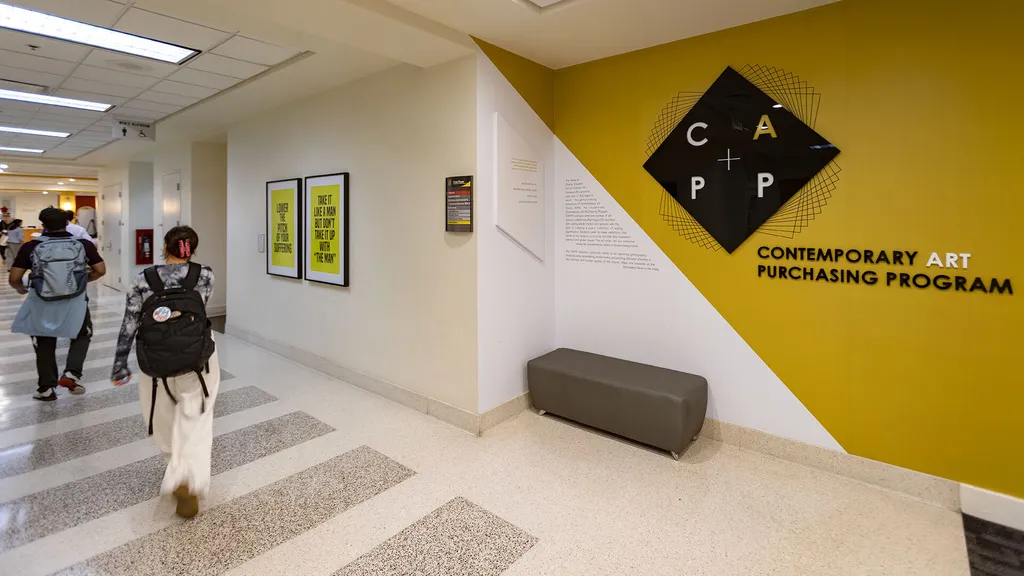- September 26, 2024
- By Sala Levin ’10
Every day, the Adele H. Stamp Student Union pulses with the energy of thousands of visitors each on their own mission: Caffeinate at the Coffee Bar. Buy a textbook at the University Book Center. Find a quiet(ish) place to crank out a paper.
Amid these quintessential campus activities, something more sophisticated is also taking place: an artistic experiment that puts students in charge of cultivating the artistic vibe of the Stamp.
Now starting its 10th
cohort, the yearlong Contemporary Art Purchasing Program at the Stamp offers art-minded undergraduates a behind-the-easel look at the art world and a healthy budget to buy original works for the Stamp’s collection of contemporary art. With the students’ input on placement, the art is displayed throughout the Stamp.

“This is their legacy,” said Tara Youngborg, manager of Stamp Gallery and Studio A, and the adviser to CAPP. “They got to say, ‘Yes, this is what I think is important for the Stamp to show.’”
Offered every other year since 2006, CAPP, which is modeled after a program at Wake Forest University, is open to undergraduates of all majors and accepts about a half-dozen for each cohort. For a year, the students meet weekly, learning the nitty-gritty of buying and collecting art.
They also visit galleries, locally and in New York City on a spring break trip, watch how artists work at their studios and pore over the existing collection, identifying any gaps or considering themes to highlight in their selections. (The last cohort purchased a ceramic, the first in the collection.)
Trin Tatum ’26, a double major in art history and American studies who’s in the current cohort, said that she’s “particularly interested in pieces around surveillance, Asian Pacific Islander work, pieces that degrade or disintegrate or change over time and larger, eye-catching pieces.”
Ultimately, the group must decide together how to spend its budget, typically around $50,000. Sometimes, Youngborg said, the group divides the funds equally and allows everyone to pick their own piece independently, but often they work jointly to select a few works that they feel are important.
Of course, the Stamp isn’t the Louvre. The people who come through its doors every day aren’t generally looking to contemplate lofty matters of art. That influences the selection process, said Youngborg, tasking students with considering how a momentary interaction with a piece of art might impact a viewer. Logistics are also a concern. “We have to consider the safety of the art and the viewers,” she said. “Something might work really well in a museum, where you’re expecting to encounter it, but not somewhere where someone could run into it or put a hole into it.”
Each week, students in the program present a few suggestions of artists or specific works for the group to discuss. “I start by looking at art publications, or by looking for galleries that align with our values, or taking advantage of social media” to find new artists, said Tatum.
Raina Hatcher ’25, a double major in art history and astronomy, is interested in depictions of science and the environment in art. She’s hoping to snag a piece by Miami-based artist Anastasia Samoylova, whose work visualizes environmental issues threatening Florida. “I love when parts of the CAPP collection can be included in courses, because then students can get hands-on experience with art,” Hatcher said.
As an alum of the program, graphic designer and artist Sarah Buchanan ’13 said that CAPP was “an experience where I could learn more about the art world and be taken seriously as someone with actual buying power.” Among the works her cohort chose was a piece by Selin Balci MFA ’12 called “Contamination 32,” which was made of microbial growth on boards.
During her decade on the advisory board that mentors CAPP participants, Buchanan has been impressed with the choices that students have made. “It’s just a joy to see what sparks their passion and what they bring to the collection,” she said. “They really discover some beautiful art.”
Topics
Arts & Culture